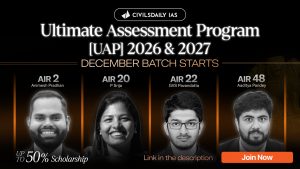Introduction
Entrance examinations in India were envisioned as a filter for talent, ensuring merit-based access to elite institutions. However, over time, they have morphed into an industry-driven rat race. From ₹7 lakh coaching fees to student suicides, the costs are both economic and human. With growing disparities in access, an illusory notion of meritocracy, and mounting psychological toll, rethinking admissions is not a choice but a necessity.
The Coaching Crisis and Its Toll
- Massive Aspirant Pool: Over 15 lakh students appear for JEE alone, making coaching almost unavoidable.
- High Costs: Coaching fees of ₹6–7 lakh for two years price out poor students.
- Early Sacrifices: Students as young as 14 years study Irodov & Krotov (beyond B.Tech level), sacrificing holistic growth.
- Mental Health Crisis: Rising stress, depression, alienation; some governments now regulate coaching centres.
- Core Issue: The examination system itself is flawed, creating overqualified candidates and distorted merit.
Why Meritocracy is an Illusion
- Tiny Differences, Big Stakes: Distinguishing between 91% vs 97% in Class 12, or 99.9 percentile in JEE is unreasonable.
- Adequate Benchmark Exists: A 70–80% score in Physics, Chemistry, Mathematics is sufficient for B.Tech readiness.
- False Hierarchies: Overemphasis on marginal score differences creates elitism and exclusion.
- Privilege Bias: Wealthier families access top coaching, creating an illusory meritocracy.
- Philosophical Insight: Harvard’s Michael Sandel critiques meritocratic obsession, proposing lotteries for elite admissions.
Global Inspirations for Reform
- Dutch Lottery System:
- Introduced in 1972, reinstated in 2023 for medical school.
- Weighted lottery: minimum eligibility required, higher grades = higher chances.
- Promotes diversity, fairness, and reduced pressure.
- China’s “Double Reduction Policy” (2021):
- Banned for-profit coaching overnight.
- Reduced financial burden and youth stress.
- Addressed unchecked growth of the coaching industry.
Proposed Solutions for India
- Lottery-based Allocation:
- Threshold of 80% in PCM for eligibility.
- Weighted lottery with categories (90%+, 80–90%): A weighted lottery with categories (90%+, 80–90%) means all eligible students enter a lottery, but those with higher marks get proportionally better chances of selection.
- Reservations integrated (gender, rural, region).
- Rural Empowerment: 50% IIT seats for rural govt school students to promote social mobility.
- Coaching Reform: Ban/nationalise coaching, provide free online lectures & study material.
- Diversity & Integration: Student exchange between IITs to break hierarchies.
- Faculty transfers to standardise academic quality.
Conclusion
India’s choice is stark: continue a toxic rat race that scars its brightest minds, or embrace a fair, equitable system that nurtures youth. Scrapping or reforming entrance exams through lotteries, trust in Class 12 boards, rural reservations, and coaching reforms can detoxify the system. The aim must not only be producing engineers and doctors but ensuring the emotional, social, and moral growth of India’s future citizens.
Value Addition |
Committee Recommendations & Policy Inputs
|
PYQ Relevance
[UPSC 2024] What are the aims and objectives of the recently passed and enforced, The Public Examination (Prevention of Unfair Means) Act, 2024? Whether University/State Education Board examinations, too, are covered under the Act?
Linkage: The Public Examination (Prevention of Unfair Means) Act, 2024 seeks to curb frauds like paper leaks and impersonation to restore exam credibility. The article extends this concern by highlighting systemic unfairness — coaching dependence, stress, and privilege-driven access. Together, they underline that ensuring fairness in exams requires not just legal safeguards but also structural reforms in India’s entrance system.
Get an IAS/IPS ranker as your 1: 1 personal mentor for UPSC 2024

